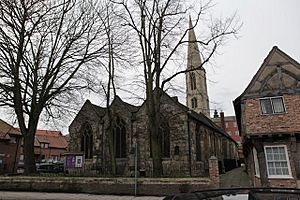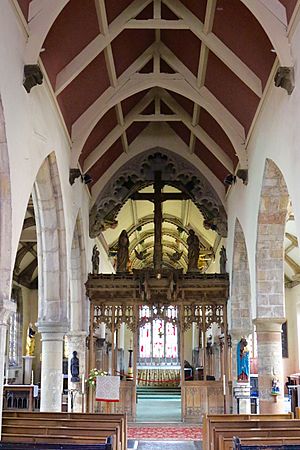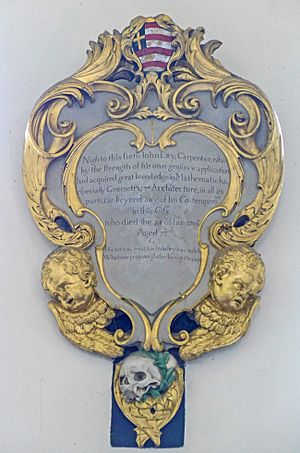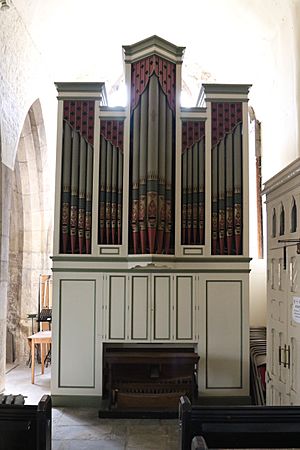All Saints' Church, North Street, York facts for kids
Quick facts for kids All Saints' Church, North Street, York |
|
|---|---|

All Saints' Church, North Street, York
|
|
| 53°57′30.4″N 1°5′10.3″W / 53.958444°N 1.086194°W | |
| Location | York |
| Country | England |
| Denomination | Church of England |
| Previous denomination | Roman Catholic |
| Churchmanship | Traditional Catholic |
| Website | allsaints-northstreet.org.uk |
| History | |
| Dedication | All Saints |
| Architecture | |
| Heritage designation | Grade I listed |
| Administration | |
| Parish | All Saints, North Street, York |
| Deanery | York |
| Archdeaconry | York |
| Diocese | Diocese of York |
| Province | Province of York |
All Saints' Church is a historic Church of England building. It is located on North Street in York, North Yorkshire. This church is very important, so it is listed as a Grade I listed building. This means it is a building of special architectural or historic interest.
Contents
A Look at All Saints' Church History
The oldest part of All Saints' Church is the nave, which was built in the 1100s. The arches inside the church were added in the 1200s. The eastern part of the church was rebuilt in the 1300s. This is when the small chapels next to the main altar were also added.
The Anchorite's Home
In the 1400s, a special small building was added to the west end of the church. This was for an "anchorite." An anchorite was a person who chose to live alone in a small room. They dedicated their life to prayer and religious thought. A small opening, called a squint, was made in the wall. This allowed the anchorite, Emma Raughton, to see and hear the church services. This special room was rebuilt in 1910.
Later, in the 1930s, a man named Brother Walter Wilman lived in this anchorite cell. He was a former clothworker and church helper. He lived in the small room, which was about 8 by 10 feet, until he passed away in the 1970s. He could have visitors and watch church services from his room.
Church Renovations Over Time
The church has been repaired and updated many times. Between 1866 and 1867, a big restoration took place. The south wall was rebuilt, and a porch and a room for the clergy (vestry) were added. Half of the roof was replaced, and new seats were put in. The old paint and dirt were cleaned from the walls and pillars. A new organ was also installed. This work cost about £1,500 at the time.
In 1906, a beautiful screen was put in front of the chancel (the area around the altar). It was designed by E. Ridsdale Tate. He also rebuilt the anchorite's house in 1910. The church was restored again in 1991 by architect Peter Marshall.
The pulpit, where sermons are given, dates back to 1675.
Amazing Stained Glass Windows
All Saints' Church is famous for its incredible collection of medieval stained glass. It has some of the best old glass in York, second only to York Minster. Most of these beautiful windows were made in the early 1300s.
Famous Windows to See
One of the most well-known windows shows scenes from the Prick of Conscience. This window, made around 1410, illustrates the Fifteen Signs before Doomsday. These are old ideas about events that would happen before the end of the world.
Another famous window is called The Corporal Acts of Mercy. This window shows six of the seven acts of kindness that Christians are encouraged to do. It's not known why the seventh act (burying the dead) is not shown. The window also shows the Blackburn family. Nicholas Blackburn, who was the mayor of York at the time, is believed to have paid for this window.
Other Notable Windows
As you walk through the church, you can see many other beautiful windows:
- A set of 15th-century coats of arms.
- The St Thomas window, from around 1410.
- The Lady Chapel east window, from around 1330.
- The Chancel east window, from around 1410.
- The south aisle east window, from around 1350.
- The St Michael and St John window, from around 1430.
- The Nine Orders of Angels window, from around 1410.
- The St James window, from around 1410.
Memorials and Organ
Important Memorials
Inside the church, there are memorials to several people from history. These are special plaques or carvings that remember people who were important to the church or the community. Some of the people remembered include:
- John Etty (died 1709)
- Revd. John Stoddart
- Joan Stoddart (died 1599)
- James Pennyman (died 1699)
- Joshua Witton (died 1674)
- William Stockton (died 1471)
- Robert Colynson (died 1458)
- Thomas Clerk (died 1482)
- Thomas Askwith (died 1609)
- Charles Townley (died 1712)
The Church Organ
The church has a large pipe organ. It was built by a company called Forster and Andrews in 1867. You can find more details about this organ on the National Pipe Organ Register.














